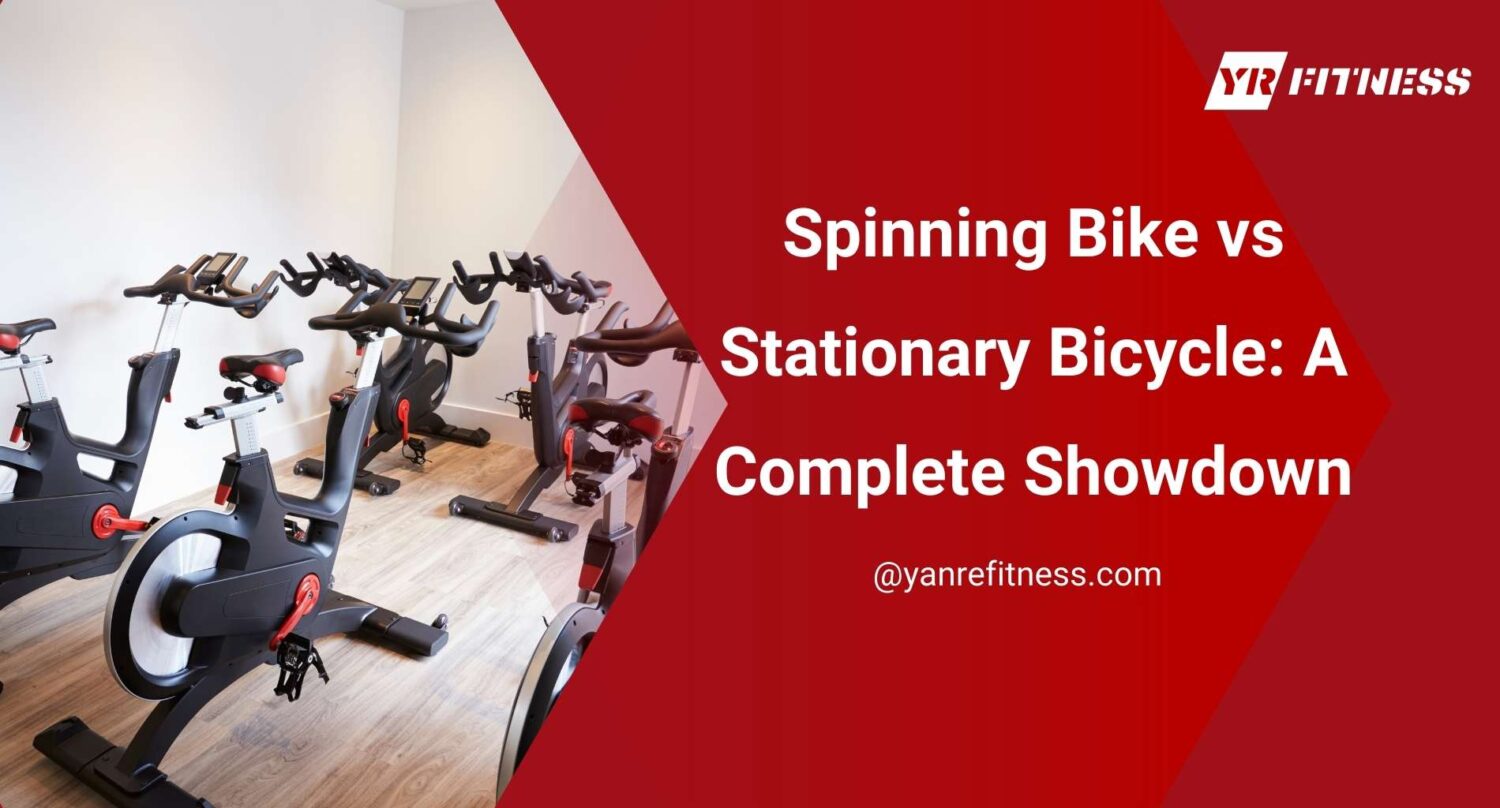“Should I go with spinning bikes or stationary?”
I’ve heard that question more times than I can count.
And I get it. When you’re investing in equipment whether for your gym or your catalog you want to get it right the first time.
I’ve opened gyms. Helped distributors build smart catalogs. And personally tested both types of bikes.
This article lays out everything I’ve learned:
- What makes a spinning bike different from a stationary one
- Which one members use more
- Which holds up better over time
By the end, you’ll be able to pick the right bike for your gym or help your customers pick the right one for theirs.
So let’s start!
- 1. What is a Spinning Bike?
- 2. What is a Stationary Bicycle?
- 3. Feature Comparison: What Sets Them Apart?
- 4. Durability and Maintenance: Long-Term Business Value
- 5. Member Experience: Which Bike Keeps People Coming Back?
- 6. Space and Layout: Will It Fit Your Gym Design?
- 7. Cost, Value, and ROI for Gym Businesses
- 8. Which Bike Matches Your Business Model?
- 9. Final Verdict: Which One Should You Choose?
- Conclusion
1. What is a Spinning Bike?
You’ve probably seen them in group classes rows of bikes, loud music, an instructor shouting over the beat. That’s a spinning bike.
It looks like a regular bike at first. But once you hop on, you’ll feel the difference.
Spinning bikes are built for high-intensity training. They’re made to handle sweat, speed, and serious effort. You can pedal fast, stand up, sit down, or push through resistance like you’re climbing a hill.
Here’s what sets a spinning bike apart:
- Heavier flywheel (it keeps the pedals moving smoothly)
- Adjustable resistance (you turn a knob to make it harder or easier)
- Strong frame (made for standing and sprinting)
- Racing-style seat and handlebars
- Simple screen, or sometimes no screen at all
I remember my first time using one. I was dripping with sweat in under five minutes. But I felt great afterward. That’s the kind of ride people come back for.
In gyms, spinning bikes are often used in classes. Members follow an instructor who guides them through different intervals, fast sprints, slow climbs, and rest periods. It keeps things exciting.
They’re also great for solo riders who want a challenge.
If you’re stocking a gym or helping a client choose bikes, this matters. Spinning bikes aren’t casual. They’re for people who want a workout, not just a ride.
And that’s why so many commercial gyms invest in them. Because when members get results, they keep coming back.
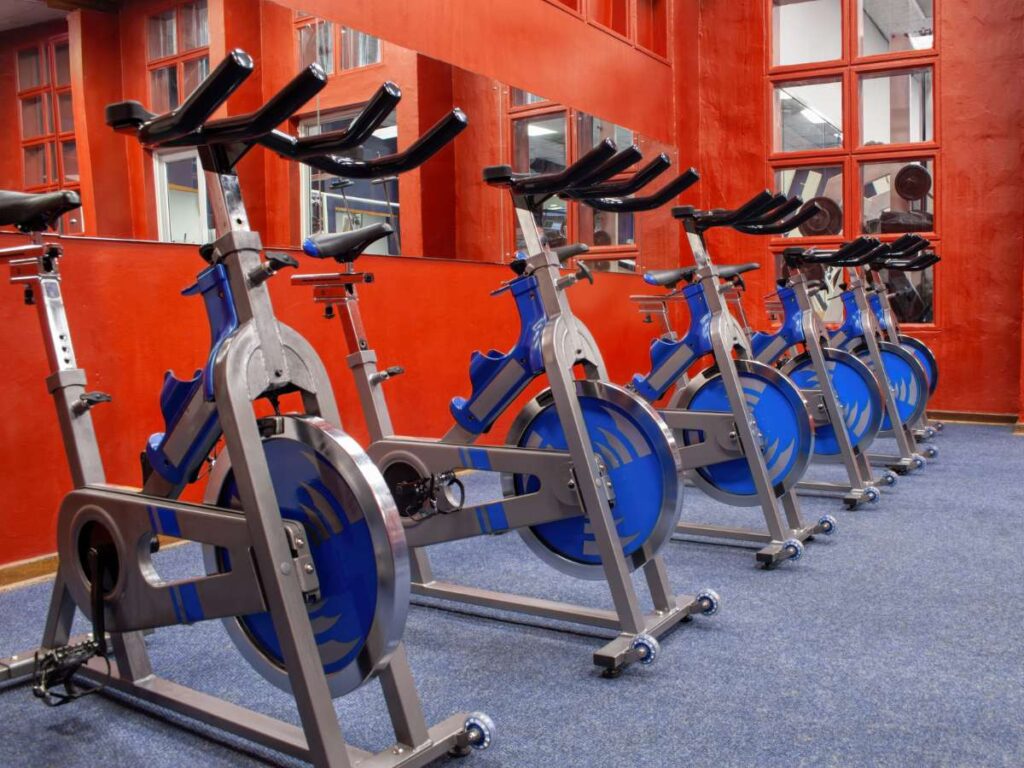
2. What is a Stationary Bicycle?
If you’ve ever sat on a bike at the gym that felt more like sitting in a chair relaxed, upright, easy to use you were probably on a stationary bike.
These bikes are made for comfort. And for steady, low-impact workouts.
They don’t look flashy. They don’t demand much. But that’s what makes them popular especially for beginners, older adults, or anyone recovering from injury.
There are two common types:
- Upright bikes (look and feel like outdoor bikes)
- Recumbent bikes (have a backrest and pedals in front of you)
Both types let you pedal at your own pace. No pressure. No rush.
I remember setting up a gym for a rehab center a few years back. We placed four recumbent bikes by the windows. Every morning, those bikes were full. People liked low effort and smooth motion. And they felt safe using them.
Here’s what makes a stationary bike different:
- Wider seat
- Back support (for recumbent models)
- Basic screen with speed, time, distance, and calories
- Quiet pedaling
- Lighter flywheel compared to spinning bikes
These bikes aren’t built for sprinting or heavy resistance. But they shine in long, steady sessions.
For gym owners or distributors, stationary bikes can fill a key need. They’re accessible. They’re dependable. And they’re easy to maintain.
If your clients want options for all fitness levels, this is a solid choice.
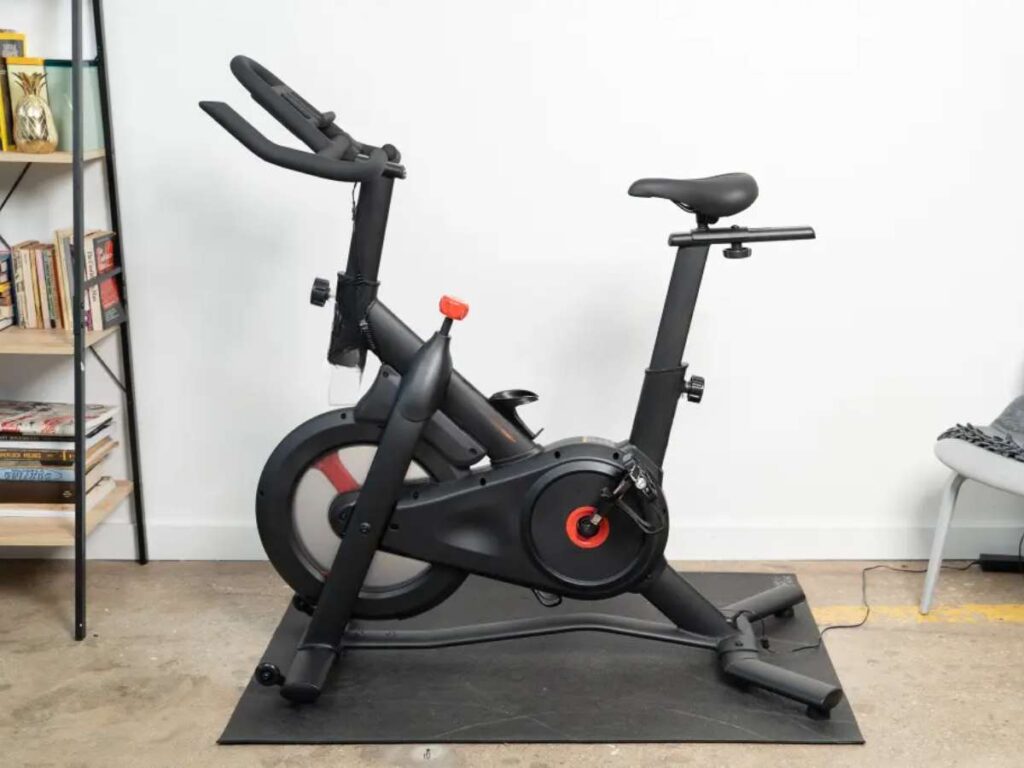
3. Feature Comparison: What Sets Them Apart?
If you’re choosing bikes for your gym or deciding what to offer your clients, you need to look beyond the price tag. What really matters are the features and how they match your users.
Let’s break it down.
Design and Mechanics
Spinning Bikes These bikes are built for performance. Fast pace. Heavy sweat.
- They use a heavier flywheel, which keeps the motion smooth, even during sprints
- You can adjust the handlebars and seat to fit a more aggressive riding posture
- They’re made for standing pedaling, which means they’re great for intervals and serious cardio sessions
When I stocked a small group training gym, we chose spinning bikes. The members wanted a challenge. They were younger, already active, and loved pushing limits. Those bikes never sat idle.
Stationary Bicycles These bikes lean more casually.
- Most have an upright or recumbent design for relaxed posture
- The flywheel is lighter, which makes the ride feel easier and less intense
- They come with pre-set programs, so users just choose a level and start pedaling
I remember one gym in a retirement community. We filled one corner with upright bikes. They weren’t flashy—but they were always in use. The design made sense for that crowd.
So think about your users. Do they want intensity and movement, like in spin-focused group programs? Or steady, comfortable cardio?
Resistance System and Intensity Options
Spinning Bikes
- Use manual or magnetic resistance
- The tension knob lets riders control how hard they work
- Great for high-intensity intervals and climbing drills
Stationary Bikes
- Offer digital resistance with pre-set levels
- Users can choose light to moderate settings
- Better for steady rides, physical therapy, or warming up
I once tested a spinning bike and a recumbent one back-to-back. The spinning bike left my legs burning. The recumbent? I could’ve read a book while pedaling.
That’s not a bad thing. It’s just different.
So ask yourself: Who are you serving? A high-energy spin class? Or folks looking for a quiet, easy ride?
Knowing that will help you pick the bike that actually fits your space and your people.
4. Durability and Maintenance: Long-Term Business Value
When you run a gym or supply one you’re not just thinking about today. You’re thinking about years down the line. What breaks. What lasts. What costs more later.
That’s why durability and maintenance matter. A lot.
Build Quality and Material Strength
Spinning Bikes
Spinning bikes are built like tanks.
- Most use commercial-grade steel frames
- They’re made to hold up under pressure sweat, movement, heavy use
- Good ones feel solid even when riders are standing and sprinting
In one gym I helped outfit, we placed ten spinning bikes in a group class studio. After two years of constant use, only one needed a major repair. That’s the kind of build you want for high-traffic zones.
Stationary Bikes
These bikes are usually lighter and more compact.
- The frames can still be strong, but they aren’t made for hard impacts
- Better for low-intensity use, like warm-ups or long steady rides
- Not ideal for repeated, high-power workouts in group settings
They’re perfect in quieter corners or spaces that focus on general wellness rather than intense training.
Maintenance Considerations
Spinning Bikes
With more moving parts, they need a bit more care.
- Many use a chain or belt drive, which may need tensioning or oil
- Flywheels need wiping down
- Pedals and resistance knobs wear out over time
If you’ve got staff who check equipment weekly, it’s manageable. But ignore it and breakdowns will catch you off guard—just like with other cardio gear, such as ellipticals vs rowers, where upkeep needs vary by training intensity.
Stationary Bikes
- Simpler builds
- Fewer moving parts, so they’re easier to maintain
- Digital consoles may glitch now and then, but parts wear slower
At one gym, we had a few recumbent bikes that went five years with almost no issues—just basic cleaning and an occasional battery swap.
Tip: Choose bikes that offer easy access to parts. Look for brands that stock replacements. And make sure your team knows how to do simple fixes.
In short: Spinning bikes may need more care but they give more performance. Stationary bikes ask less but deliver steady value.
Know what your space can handle. That’s how you protect your investment.
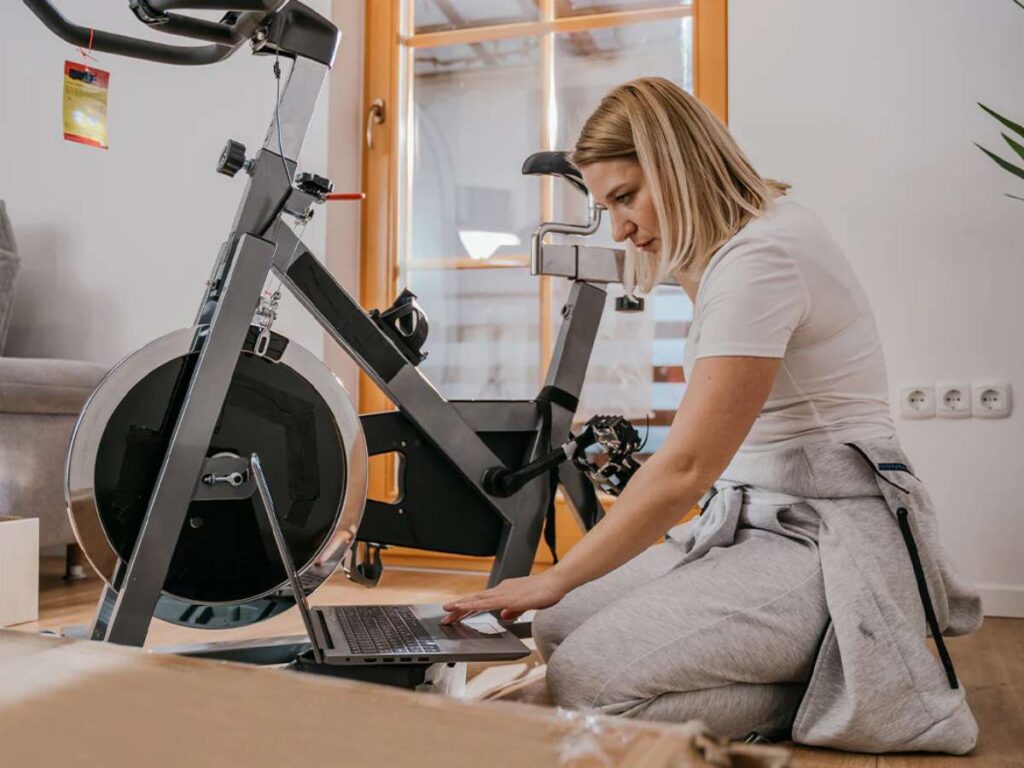
5. Member Experience: Which Bike Keeps People Coming Back?
You can buy the most expensive bike on the market. But if your members don’t enjoy using it? It’s going to sit empty.
That’s why member experience matters. Because the best equipment is the one that gets used again and again.
Comfort and Ergonomics
Spinning Bikes
Spinning bikes are built for serious riders.
- The seat is small and firm
- The position leans forward, like a road bike
- Riders can stand, pedal hard, and push through sprints
But they do need some setup.
Handlebars too low? Back pain.
Seat too high? Sore knees.
I’ve seen new members hop on and get discouraged just because no one helped adjust the bike.
Once they had guidance, though? They loved the challenge.
Stationary Bikes
These are easier to use right away.
- Bigger seat
- Upright or reclined posture
- Less strain on the back, neck, and joints
They’re popular with older adults, casual users, and those easing into fitness.
I’ve had members tell me they felt safe using them and that kept them coming back.
Program Variety and Engagement
Spinning Bikes
- Work best in group class settings
- Instructors lead the pace, intensity, and mood
- Riders feel connected and motivated
Some bikes also work with apps that track stats or play virtual rides.
It keeps things fresh even for solo workouts.
Stationary Bikes
- Offer built-in programs like “hill climb” or “fat burn”
- Most have screens for stats or entertainment
- Some sync with apps or streaming services
I remember one member who showed up every day, tablet in hand, ready to watch her show while pedaling. That was her routine and she never missed a day.
Tip: Think about who your members are.
- Want to build a strong group training culture? Go spinning bikes.
- Want to serve beginners, seniors, or casual users? Stationary bikes may be the better fit.
Pick the bike that fits your people, not just your floor space. That’s how you create loyalty.
6. Space and Layout: Will It Fit Your Gym Design?
You can have the best bike in the world. But if it doesn’t fit your floor plan, it won’t work.
Space matters. A lot more than people think.
Before you order bikes, stop and take a good look at your gym layout. What fits on paper doesn’t always work in real life.
Spinning Bikes
Spinning bikes are usually more compact.
- Smaller footprint
- Can be lined up tight, row by row
- Easy to move when needed
That’s why you’ll see them in group training studios.
You can fit 10 to 15 in a single room without making it feel crowded.
I once helped a gym owner who only had 300 square feet to work with. We managed to fit a full spin class setup. Tight? Yes. But it worked.
If you want to offer group classes and save space, spinning bikes are a smart choice.
Stationary Bikes
Stationary bikes, especially recumbent models, need more room.
- Wider base
- Built-in screens or consoles
- Seats that don’t tuck in as neatly
They’re great for individual workouts, but they take up space especially if you place them side by side.
In one gym I worked with, we added six recumbent bikes near the entrance. It looked fine at first. But as the gym got busier, traffic jammed up in that corner. We had to rearrange the whole layout.
Tip: Measure your open floor space before you place a bulk order.
And think about flow:
- Will people walk past these bikes often?
- Can staff clean around them easily?
- Is there enough space between bikes for comfort and privacy?
Sometimes a few inches make a big difference.
And choosing the right bike for the right spot? That’s what helps your gym feel organized, open, and member-friendly.
7. Cost, Value, and ROI for Gym Businesses
Buying gym equipment isn’t just about price it’s about what you get back from it.
And bikes? They’re one of the most-used pieces in any gym. But not all bikes give you the same return.
Let’s break it down so you don’t spend more than you need or less than you should.
Purchase Cost and Setup
Spinning Bikes
- Price for commercial models usually falls between $700 and $1,500
- Most don’t come with screens, so no monthly software fees
- You may need maintenance kits lubricant, tools, and occasional belt or chain replacement
Stationary Bikes
- Can range from $1,000 to $3,000+, especially recumbent styles with screens
- Many offer built-in digital consoles that may require subscriptions for app access
- Shipping and setup can cost more due to their size and weight
I once worked with a gym that bought eight recumbent bikes with large screens. Members loved them—but the monthly software bill? It added up fast. They hadn’t planned for that.
Lifespan and ROI
Spinning Bikes
- Made for heavy use group classes, personal training, solo rides
- Even with more wear and tear, they tend to pay off quickly
- In one studio I helped launch, they got a full return in under a year thanks to packed classes
Stationary Bikes
- Longer lifespan, especially with light to moderate use
- Great for steady traffic but don’t drive high class revenue
- Best in rehab centers, senior fitness rooms, or general cardio zones
Advice: Think about how many members will use the bikes and how often.
- If you run group sessions and high-energy classes, spinning bikes can make money fast
- If your gym serves casual users or seniors, stationary bikes offer low-maintenance value over time
At YR Fitness, we build commercial bikes for every kind of setup—from high-energy spin studios to wellness centers that need reliability and ease of use.
Choose based on who you serve and how fast you need the return. Because the right investment doesn’t just fill space. It brings your gym real value, month after month.
8. Which Bike Matches Your Business Model?
Not every gym is the same. Some run packed classes all day. Others focus on rehab or beginners. And if you’re a distributor, you’ve got to think even bigger what sells, what lasts, and what people actually want.
So let’s match the right bike to the right setup.
Best Choice for Group Classes
If your gym runs instructor-led classes, spinning bikes are the way to go.
- Built for high-energy workouts
- Perfect for HIIT, endurance rides, and interval training
- Riders can stand, sprint, and push hard
I once set up a boutique gym with 12 spinning bikes. They launched with just two classes a day. Within three months, they had six daily sessions and waitlists. Why? The bikes helped create an experience people came back for.
Tip: Want to boost member retention? Group classes do that. And spinning bikes are the foundation.
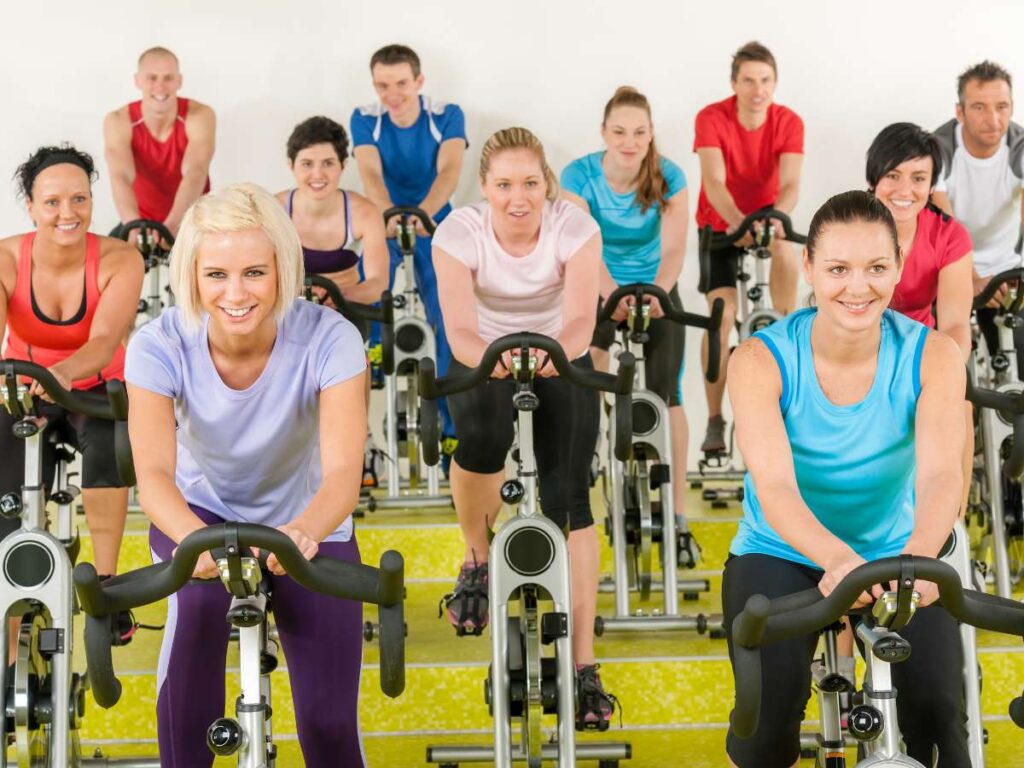
Best Choice for General Cardio Zones
If your focus is more open-access cardio, stationary bikes make sense.
- Upright bikes work well for most users
- Recumbent models are ideal for seniors, beginners, and those with mobility issues
- Quiet, simple, and easy to use without staff help
I’ve seen these bikes do especially well in hotel gyms, wellness centers, and rehab spaces. People walk in, hop on, and pedal at their pace.
No pressure. No need for training. Just consistent use.
Distributor Considerations
If you’re a distributor, your choices affect more than one gym.
- Watch local demand. Boutique and training-focused gyms often ask for spinning bikes
- General fitness clubs may want a mix, especially if they serve a wide range of ages
- Ask suppliers about warranty terms and bulk deals those details matter when stocking at scale
And don’t forget support. You want equipment that’s easy to fix, with readily available parts.
In the end, the right bike depends on your model. Think about who you’re serving, what they value, and how your space works. The answer will be clear.
9. Final Verdict: Which One Should You Choose?
If you’re still torn between a spinning bike and a stationary bicycle, you’re not alone.
I’ve had gym owners, franchise managers, and first-time distributors ask me this question over and over. The truth is both bikes work well. But they don’t work well for every situation.
It all depends on who you serve, how much space you have, and what your business needs right now.
Here’s a quick way to make the call:
Think About Your Target Audience
- Young, active members who love group classes? Go with spinning bikes.
- Older adults, rehab users, or beginners? Stationary bikes, especially recumbent ones, are a better match.
- Mixed crowd? You might need both.
I’ve seen gyms thrive by mixing it up spin studio in the back, cardio zone in the front. It gave everyone a place to ride their way.
Budget and Cost
- Spinning bikes are cheaper upfront and bring fast returns through classes.
- Stationary bikes cost more, but they last longer and need less attention.
Make sure you factor in hidden costs like subscriptions or parts. Those can sneak up on you.
Space and Layout
- Tight on space? Spinning bikes line up easily in rows.
- Have more room or want comfort-focused stations? Stationary bikes are ideal.
I once worked with a small downtown gym. We only had space for five bikes. We chose compact spinning models from YR Fitness and still managed to run two full classes a day. Layout made the difference.
Member Goals
- Weight loss, endurance, or intense cardio? Spinning.
- General health, rehab, or steady movement? Stationary.
In the end, it’s about fit.
Not just how the bike fits the floor but how it fits the people you serve. Choose with that in mind and you won’t go wrong.
Conclusion
You’ve seen the difference.
Spinning bikes bring energy. Stationary bikes bring comfort.
I’ve used both. Sold both. Watch members fall in love with one or ignore the other.
Now it’s your turn to decide what fits your gym or distribution model.
Need high-intensity class vibes? Spinning is the way. Need steady cardio zones for all ages? Go with stationary.
Start now. Revisit each section. Use the checklist. Make your plan.
Still unsure? Contact us today we’ll help you figure it out.
Related articles:
